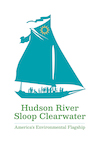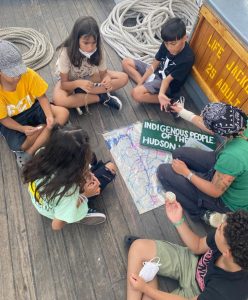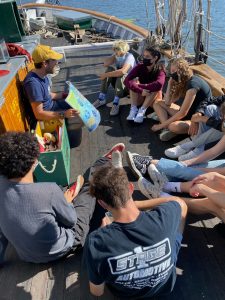About
Hudson River Sloop Clearwater is a member-supported, non-profit organization whose mission is to protect the Hudson River by inspiring lifelong stewardship of the river and its tributaries with innovative advocacy through education programs.
The organization owns and operates a historic 106′ Hudson River Sloop replica, recognized as America’s Environmental Flagship. Continuing historic sloops’ tradition as a vital link between communities, Clearwater carries a message of preservation and protection of our region’s waterways to her passengers and those who see her iconic sails from the shore.
More than 50 years later, Clearwater is recognized for its award-winning environmental education programs, through which students investigate the ecology, history, and environmental challenges of the Hudson Valley– fostering generations of environmental stewards in local communities.
To date, more than half a million people have experienced their first real look at an estuary’s ecosystem aboard the sloop.
History
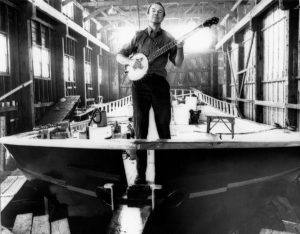 Sixty years ago, the Hudson River was near death from decades of industrial polluters. In 1966, folk musician and activist Pete Seeger, was in despair over the pollution of his beloved Hudson River. After reading the seminal texts, A Silent Spring by Rachel Carson (1962) and Sloops of the Hudson by William Verplanck and Moses Collyer (1908), he announced plans to “build a boat to save the river” along with his wife, Toshi, and a dedicated group of fellow musicians and activists. They believed that a replica of the historic sloops that once sailed the Hudson would allow people to experience its beauty and be moved to preserve it.
Sixty years ago, the Hudson River was near death from decades of industrial polluters. In 1966, folk musician and activist Pete Seeger, was in despair over the pollution of his beloved Hudson River. After reading the seminal texts, A Silent Spring by Rachel Carson (1962) and Sloops of the Hudson by William Verplanck and Moses Collyer (1908), he announced plans to “build a boat to save the river” along with his wife, Toshi, and a dedicated group of fellow musicians and activists. They believed that a replica of the historic sloops that once sailed the Hudson would allow people to experience its beauty and be moved to preserve it.
Through decades of local organizing, Clearwater equipped Hudson River Valley communities with the most important resource to become active stewards of their environment — knowledge. In 2004, the sloop Clearwater was named to the National Register of Historic Places for its groundbreaking role in the environmental movement.
Since its launch in 1969, Clearwater has become a grassroots model for producing positive change – from advocacy education for grassroots groups to award winning, place based environmental programs for local youth, Clearwater empowers Hudson Valley communities to ensure that polluters are held accountable, industrial development curtailed, and laws enshrined to protect our river codified by local, state, and federal officials.
Get acquainted with Clearwater’s influence on landmark environmental legislation below!
Education
Clearwater offers a variety of Hudson River-based environmental education programs. Our signature program is the “Sailing Classroom” aboard the sloop – providing a uniquely powerful platform for students to learn about the river’s natural and cultural significance. Beyond the vessel, onshore “Tideline” programming along the Hudson River, as well as in-classroom at local schools brings the Hudson River to students throughout the watershed. Clearwater’s interactive education programs provide hands-on learning to engage students and promote “learning by doing.”
For many, these programs are the introduction to the Hudson River and environmental education that can forge a connection with nature to last a lifetime. Please see our education programs brochure for more information!
The Sloop
Sloop Clearwater is a replica vessel modeled after the Dutch vessels that sailed the Hudson River in the 18th and 19th centuries with the third largest mains’l in North America. Those early cargo vessels were specially designed for the variable winds, currents and depths of the Hudson. Sailing from town to town today, the Clearwater models her course after that of the historic Dutch sloops. Their cargoes and crews were the main communication link between riverfront towns and outlying areas which now house one-tenth of this nation’s population.
In 1969, the 106-foot sloop Clearwater was launched at Harvey Gamage shipyard in South Bristol, Maine. On her maiden voyage she sailed to South Street Seaport in New York City, and then ultimately made her home on the Hudson River. Sailing every year since its launch without significant interruption or change of ownership, shows a level of stewardship rarely seen in the tall ship industry. Many other vessels have changed hands, been scrapped, or permanently moored to become restaurants and tourist attractions. 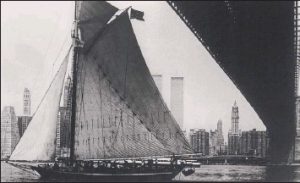
The sloop Clearwater is among the first vessels in the United States to conduct science-based environmental education aboard a sailing ship, creating the template for environmental education programs around the world. Clearwater was the first environmental group to focus on an entire river and its ecosystem, the first wooden sailing ship with a mission to preserve and protect the environment, and the first onboard environmental classroom accessible to children of all ages, races, backgrounds. Today there are several boats and organizations around the world doing environmental work and educating people using Clearwater’s hands-on method of teaching.
The Power of Music and the Great Hudson River Revival
Clearwater founders used music to affect change on topics like workers’ rights and labor unions, segregation and Civil Rights, the Vietnam War, and environmental protection. Since the maiden voyage, music has always been a powerful way to unite communities with the shared goal of protecting and preserving the Hudson River.
In our unparalleled education programs, music is one of the many components of the content we deliver, inspiring students to come up with their own Hudson River themed song verses. If you have joined us for a sail aboard Clearwater, you’ll remember the special moment of silence, which is then broken by live music, oft sung by our musically inclined crew. This powerful experience brings our attention to what we have accomplished together for the river and the sustained impact of grassroots advocacy in this community.
Beginning with the Hudson Valley Folk Picnic, fundraising concerts became crucial to sustaining Clearwater operations for years to come. The first Picnic took place in a field in Garrison (the current site of the Desmond-Fish Public Library) in October, 1966 for the express purpose of fundraising to build the sloop. The Picnic continued every year through 1977, until it was replaced by Clearwater’s Great Hudson River Revival (also known as the Clearwater Festival) in 1978.
The much beloved Great Hudson River Revival grew to be one of the country’s oldest and largest annual music and environmental festivals; award-winning for its Zero Waste program, which has been modeled at many festivals around the country. It was the main fundraiser and promotional event of Clearwater’s annual calendar until the COVID-19 pandemic in 2020 and is undergoing a re-envisioning process the organization can confidently sustain into the future.
